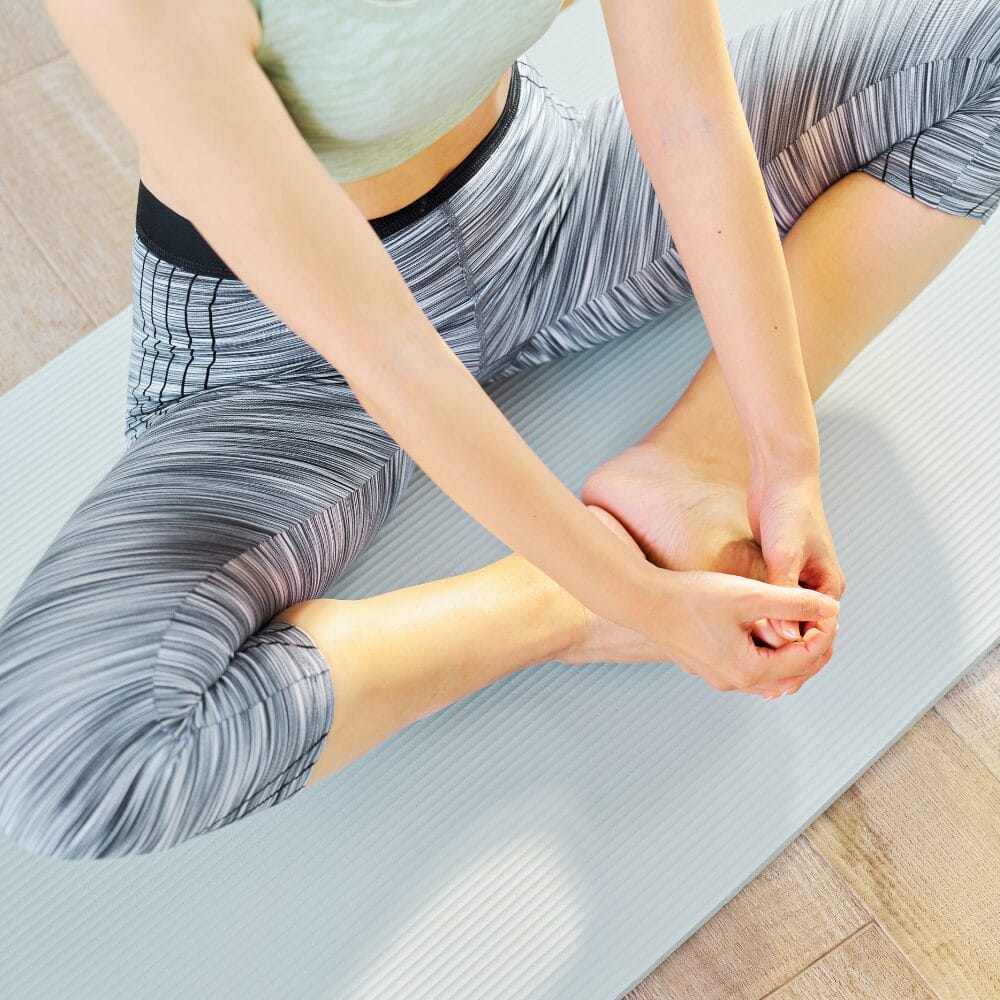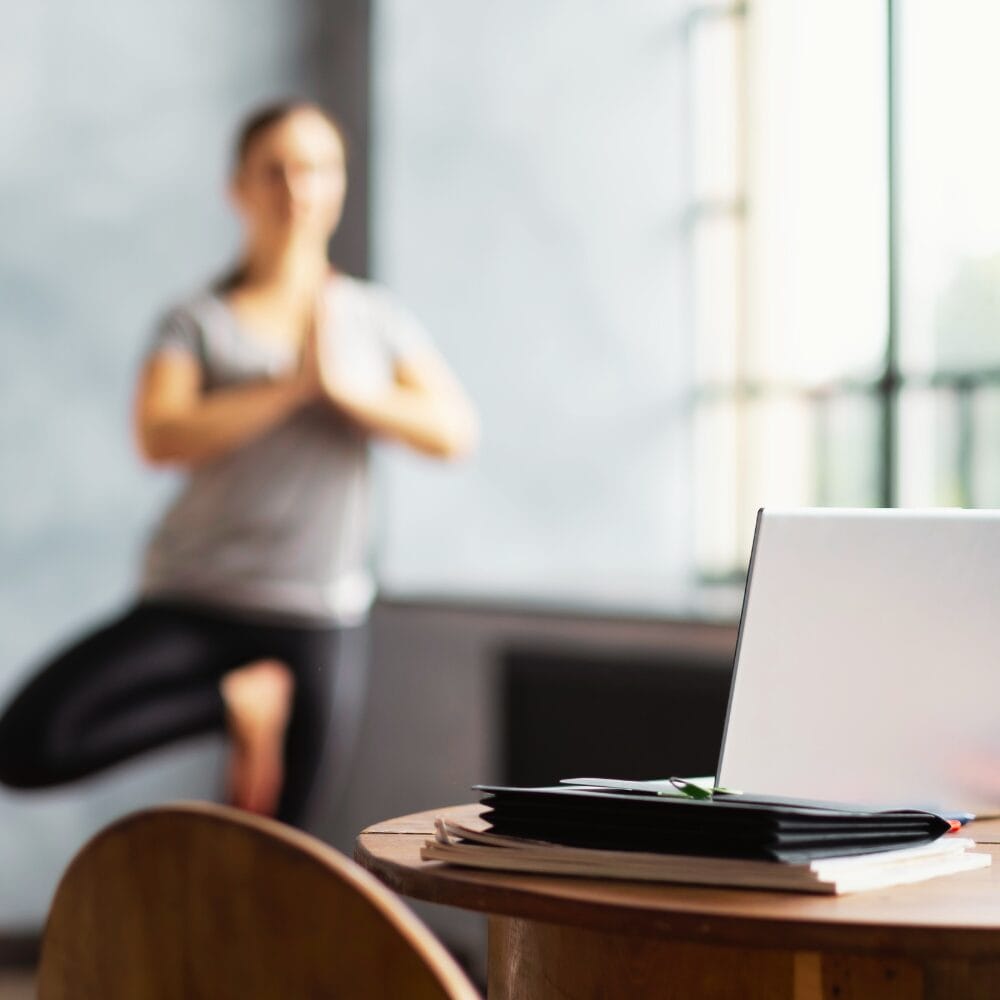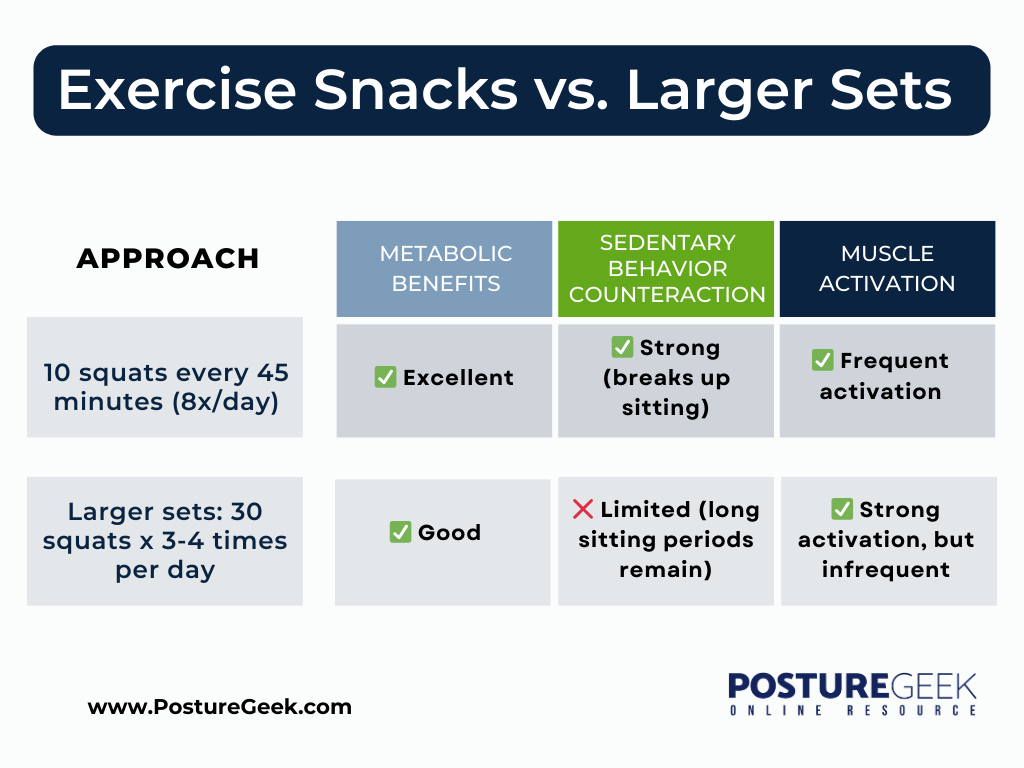Breaking Up Sitting Time: How Exercise Snacks Improve Blood Sugar More Than a 30-Minute Walk
- Updated - March 17, 2025
Are You Sitting Too Much?

Did you know that the average person sits for more than 9 hours a day? Even if you exercise regularly, prolonged sitting can still harm your metabolism. But what if the key to better health wasn’t just a long workout, but a few squats throughout your day?
A recent study found that performing 10 bodyweight squats every 45 minutes for 8 rounds throughout a workday led to better blood sugar regulation than a single 30-minute walk after prolonged sitting. This research sheds light on the power of frequent, brief movement bursts in maintaining metabolic health, especially for those at risk of diabetes and other metabolic conditions.
What are Exercise Snacks?
Exercise snacks are short, intense periods of physical activity that can be easily woven into your daily routine to boost overall health and fitness. Unlike traditional workouts that require a dedicated time slot, exercise snacks are designed to be quick, convenient, and effective. Think of them as bite-sized bursts of movement that you can fit into your day without much hassle.
For instance, instead of taking the elevator, opt for the stairs. During commercial breaks while watching TV, do a few jumping jacks. Or, take a brisk walk around the block during your lunch break. The key is to make these activities vigorous and intense, tailored to your fitness level. These small but powerful movements can significantly contribute to your physical activity goals, making it easier to stay active even on the busiest days.
What the Research Says About Exercise snacks
Studies published in the Scandinavian Journal of Medicine & Science in Sports reveal that breaking up long periods of sitting with short bursts of exercise can significantly improve glycemic control (how the body manages blood sugar).
Incorporating exercise snacks throughout the day can significantly enhance cardiorespiratory fitness (CRF), reducing the negative impact of sedentary behavior.
Instead of a single prolonged walk, short, frequent movements throughout the day help to:
- Lower post-meal blood sugar spikes
- Improve insulin sensitivity
- Keep muscles active, preventing metabolic slowdowns
- Enhance circulation and prevent stiffness
The findings indicate that mechanical stimulation of muscles, even from a few squats activates glucose uptake and helps prevent blood sugar from staying elevated for too long. In contrast, sitting for hours at a time, even if you exercise once daily can contribute to metabolic sluggishness.
Discover a practitioner near you.
Looking for a practitioner near you? Our extensive network of qualified professionals is here to help you.
The Science Behind Breaking Up Sitting Time
Breaking up sitting time with regular exercise snacks offers numerous health benefits that go beyond just burning calories. Research in exercise sciences has shown that these short bouts of activity can improve cardiovascular health, enhance muscle strength and balance, and even reduce the risk of early death. The science behind this lies in the principles of high-intensity interval training (HIIT) and sprint interval training (SIT), which involve short bursts of intense exercise followed by periods of rest or low-intensity activity.
Studies have demonstrated that even brief periods of vigorous exercise can lead to significant health benefits, such as better blood sugar control and a reduced risk of chronic diseases like heart disease and type 2 diabetes. By incorporating exercise snacks into your day, you can harness the power of these high-intensity intervals to break up long periods of sitting and improve your overall metabolic health.
Why Exercise Snacks Work: Numerous Health Benefits

When we sit for prolonged periods, our muscles become inactive, and glucose uptake slows down, leading to higher blood sugar levels. However, when we introduce exercise snacking, which involves brief but intense movements throughout the day, we stimulate muscle activity in a way that helps manage energy and glucose more efficiently.
Exercise snacks work because:
- They activate large muscle groups like the quads and glutes, which require more energy and help burn excess glucose.
- They prevent blood from pooling in inactive muscles, improving circulation.
- They trigger a metabolic response multiple times throughout the day, instead of just once after a long period of inactivity.
A Word of Caution: Ease Into It
Before diving in, take a few moments to stretch, roll your shoulders, or do a few gentle movements to warm up your muscles. Gradually build intensity to ensure a smooth transition from rest to activity and prevent discomfort.

How to Incorporate Exercise Snacks into Your Day
You don’t need to completely overhaul your routine to benefit from this approach. Exercise snacks offer flexibility compared to structured exercise routines, allowing you to integrate short bursts of activity throughout the day. Here’s a simple way to implement exercise snacks:
Even if you work in an office or at a desk, subtle movement strategies like standing up to take phone calls, stretching, or using the stairs instead of the elevator can be effective.
Who Can Benefit Most from Exercise Snacks?

Exercise snacks aren’t just for people with diabetes, they benefit everyone! You should consider incorporating them into your routine if:
- You have a desk job and sit for long hours.
- You want to maintain energy and focus throughout the day.
- You’re looking to enhance your workouts by moving more frequently.
- You have a family history of metabolic disorders and want to reduce risks.
- You struggle to find time for structured workouts but want to stay active.
Overcoming Barriers to Exercise
Finding time for exercise can be a major challenge, especially with a busy schedule. This is where exercise snacks come to the rescue. These quick and convenient bursts of physical activity can be easily integrated into your daily life, helping you overcome the time barrier. Whether you’re at work, at home, or on the go, there’s always an opportunity to fit in an exercise snack.
Lack of motivation is another common barrier. Setting small, achievable goals and tracking your progress can help keep you motivated. Exercise snacks are also highly adaptable, allowing you to modify them to suit your fitness level. Whether you’re a beginner or a seasoned athlete, you can tailor these activities to meet your needs.
By incorporating exercise snacks into your routine, you can overcome common barriers to exercise and enjoy the numerous health benefits they offer. So, start small, stay consistent, and watch as these tiny bursts of activity make a big difference in your overall health and fitness.
Does This Mean a 30-Minute Walk is Useless?
Not at all! A 30-minute walk still has significant benefits, especially for cardiovascular health, mental clarity, and general well-being. However, the key takeaway from this research is that sitting for long periods is harmful, even if you exercise later. The best strategy is to combine both approaches:
- Take short movement breaks throughout the day
- Still aim for a longer walk or workout for overall fitness
Research studies focused on the efficacy of exercise snacks for sedentary young adults have shown that short, vigorous bouts of exercise, such as stair climbing, can significantly enhance cardiovascular fitness and performance metrics.
Can You Do Larger Sets Instead of Frequent Exercise Snacks?
If you prefer to do larger sets of squats instead of breaking them up throughout the day, you might wonder if this approach still counts as an exercise snack. For example, doing 30 squats in the morning, another 30 at lunch, and two smaller sets of 10 later, would this have the same effect?
Does This Still Work?
Yes, this approach can still provide metabolic and muscular benefits, but it does not counteract prolonged sitting as effectively as breaking up sedentary time frequently. Research on exercise snacks suggests that regular movement interruptions (e.g., every 30-60 minutes) are more effective at maintaining blood sugar control, circulation, and reducing the health risks associated with prolonged sitting than fewer, larger exercise sessions.
How It Compares to Traditional Exercise Snacks

How to Make This Approach More Effective
If you prefer doing larger sets, you can still optimize their benefits by:
- Adding brief movement between sessions – Stand up, stretch, or walk for 1-2 minutes every hour.
- Spreading movement more evenly – Instead of just 3-4 larger sets, aim for at least one movement break per hour.
- Incorporating other movements – Squats are great, but alternating with lunges, push-ups, or stair climbs can enhance overall benefits.
Your approach partially fits into the exercise snack concept, but research suggests that frequent movement breaks are better than just a few larger sets for managing blood sugar and counteracting the negative effects of prolonged sitting.
If your goal is primarily muscle strength, then larger sets work well; but if you want to boost metabolism and reduce the health risks of inactivity, smaller, more frequent sets are the way to go.
Final Thoughts: Move More, More Often
If you spend long hours sitting, consider integrating exercise snacks into your routine. Not only do they improve blood sugar levels, but they can boost energy, reduce stiffness, and help prevent long-term metabolic issues. A few squats every hour might not seem like much, but the science shows that these micro-workouts add up in a big way.
Key Takeaways
- Frequent Movement Matters: Even small bursts of exercise (like 10 squats every 45 minutes) can have significant benefits for blood sugar regulation and metabolic health.
- Break Up Your Day: Regular movement breaks help combat the negative effects of prolonged sitting, keeping your muscles active and your metabolism engaged.
- It’s Not an Either/Or: A 30-minute walk still has valuable benefits. The goal is to complement longer exercise sessions with more frequent, shorter bouts of activity.
- Simple Integration: Whether at the office or at home, look for opportunities. Like taking the stairs or doing a few jumping jacks during TV commercials, to incorporate these exercise snacks into your daily routine.
PLEASE NOTE
PostureGeek.com does not provide medical advice. This information is for educational purposes only and is not intended to be a substitute for professional medical attention. The information provided should not replace the advice and expertise of an accredited health care provider. Any inquiry into your care and any potential impact on your health and wellbeing should be directed to your health care provider. All information is for educational purposes only and is not intended to be a substitute for professional medical care or treatment.
About the author
Join our conversation online and stay updated with our latest articles.
Find Expert Posture Practitioner Near You
Discover our Posture Focused Practitioner Directory, tailored to connect you with local experts committed to Improving Balance, Reducing Pain, and Enhancing Mobility.
